Sustainable Energy Goals: Analysis of Issues and Solutions Report
VerifiedAdded on 2021/09/15
|9
|2333
|46
Report
AI Summary
This report delves into the critical role of energy in achieving the Sustainable Development Goals (SDGs). It emphasizes the interconnectedness of energy with various SDGs, including poverty reduction, health, education, and gender equality. The report identifies major energy issues and challenges, such as reduced efficiency and the need for increased renewable energy usage at the utility level. It then proposes a range of solutions, including adopting rail transportation, implementing solar photovoltaic rooftops, promoting alternative-fueled vehicles, and building smart grids. The conclusion highlights the importance of energy sustainability for achieving global transformation by 2030 and stresses the need for recognizing energy's role and addressing associated challenges.
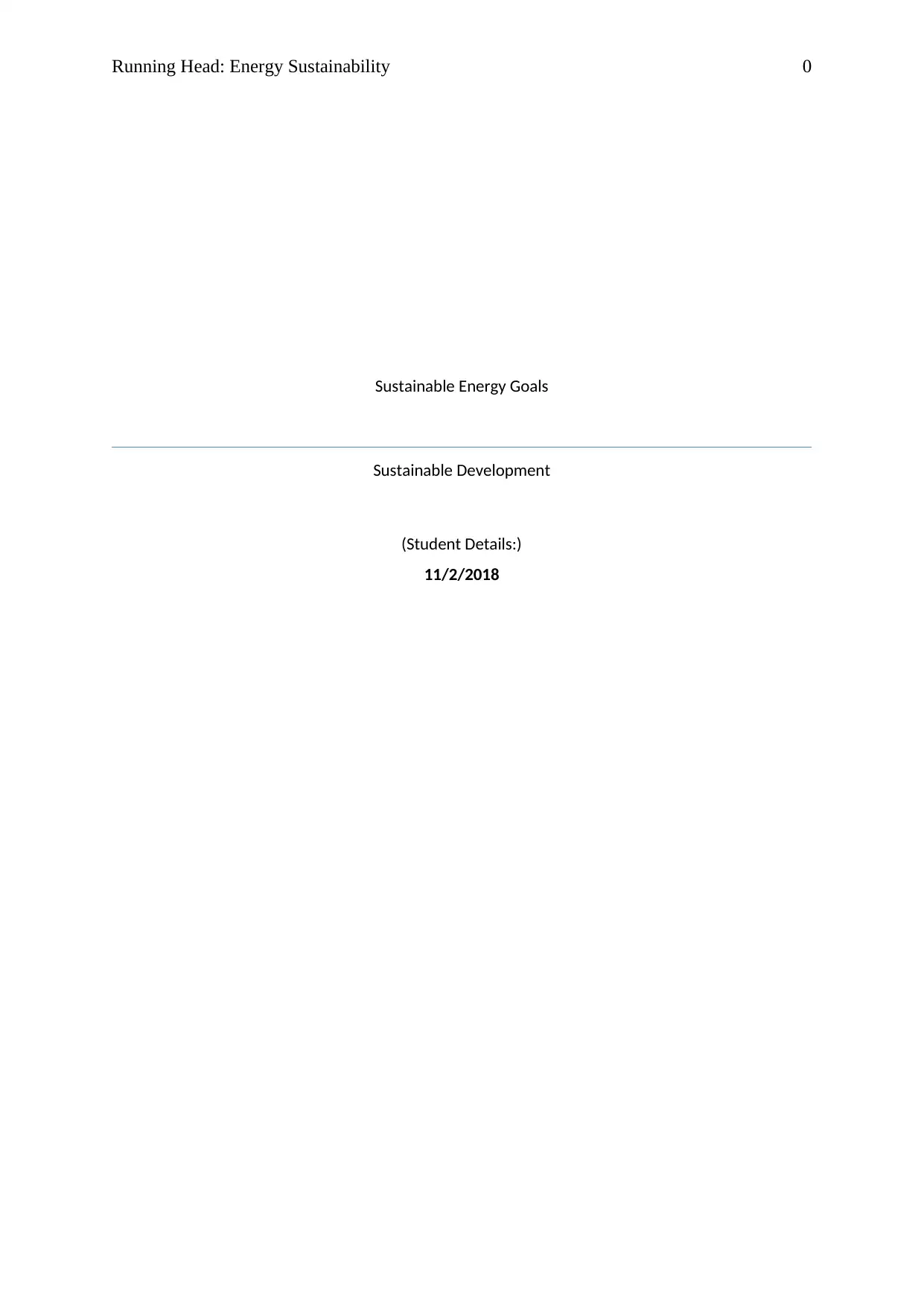
Running Head: Energy Sustainability 0
Sustainable Energy Goals
Sustainable Development
(Student Details:)
11/2/2018
Sustainable Energy Goals
Sustainable Development
(Student Details:)
11/2/2018
Paraphrase This Document
Need a fresh take? Get an instant paraphrase of this document with our AI Paraphraser

Sustainable Energy Goals 1
Contents
Sustainable Energy Goals..........................................................................................................2
Introduction................................................................................................................................2
Sustainable development concepts.............................................................................................2
Energy role in the SDGs............................................................................................................3
Probable main energy issues and challenges while achieving SDGs........................................4
Reduced efficiency.................................................................................................................5
Utility level renewables usage...............................................................................................5
Possible solutions for the sustainable energy issues..................................................................5
Adopting rail transportation...................................................................................................5
Solar photo voltaic rooftops...................................................................................................5
Alternative fuelled vehicles....................................................................................................5
Building SMART Grid...........................................................................................................6
Conclusion..................................................................................................................................6
References..................................................................................................................................7
Contents
Sustainable Energy Goals..........................................................................................................2
Introduction................................................................................................................................2
Sustainable development concepts.............................................................................................2
Energy role in the SDGs............................................................................................................3
Probable main energy issues and challenges while achieving SDGs........................................4
Reduced efficiency.................................................................................................................5
Utility level renewables usage...............................................................................................5
Possible solutions for the sustainable energy issues..................................................................5
Adopting rail transportation...................................................................................................5
Solar photo voltaic rooftops...................................................................................................5
Alternative fuelled vehicles....................................................................................................5
Building SMART Grid...........................................................................................................6
Conclusion..................................................................................................................................6
References..................................................................................................................................7
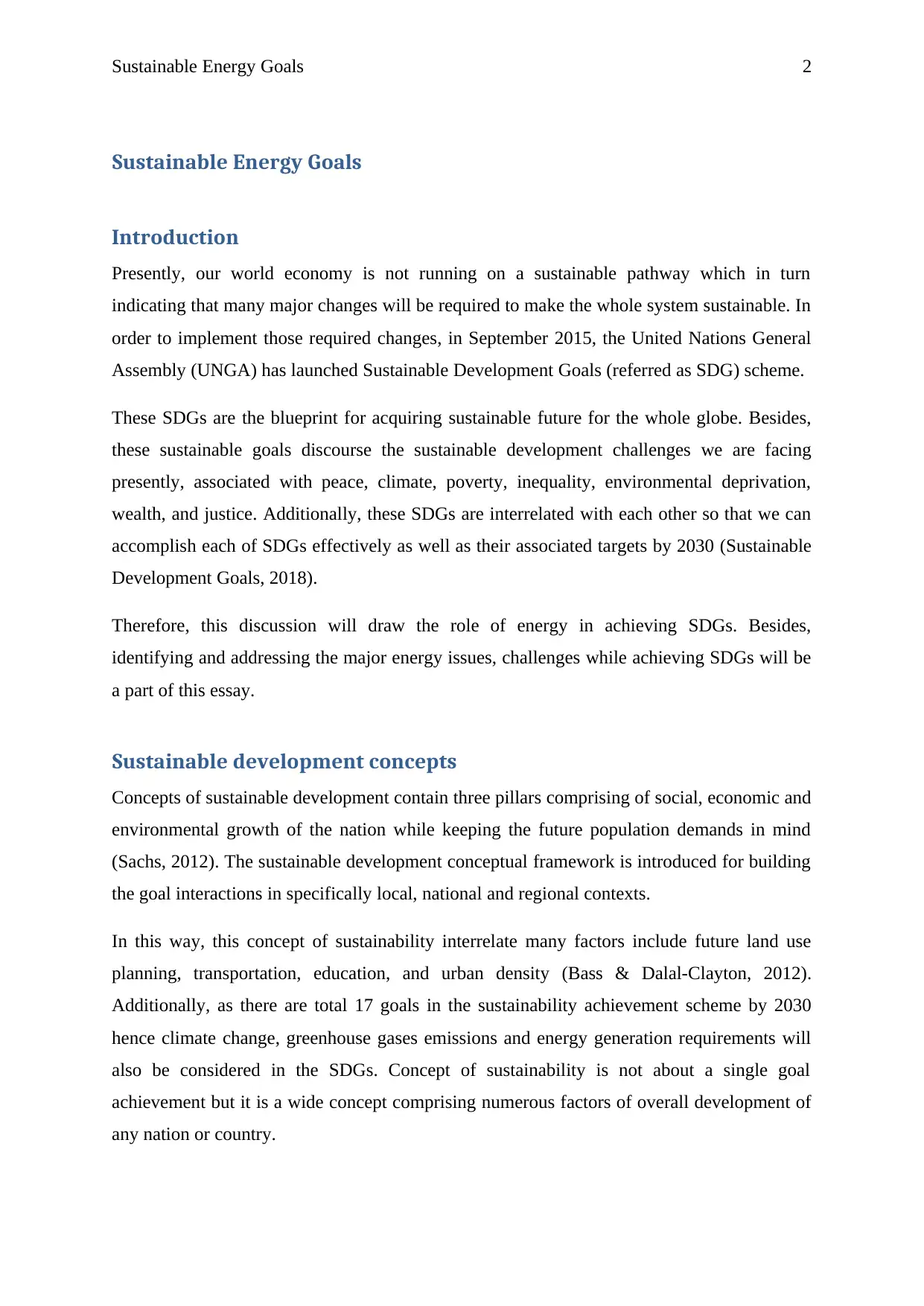
Sustainable Energy Goals 2
Sustainable Energy Goals
Introduction
Presently, our world economy is not running on a sustainable pathway which in turn
indicating that many major changes will be required to make the whole system sustainable. In
order to implement those required changes, in September 2015, the United Nations General
Assembly (UNGA) has launched Sustainable Development Goals (referred as SDG) scheme.
These SDGs are the blueprint for acquiring sustainable future for the whole globe. Besides,
these sustainable goals discourse the sustainable development challenges we are facing
presently, associated with peace, climate, poverty, inequality, environmental deprivation,
wealth, and justice. Additionally, these SDGs are interrelated with each other so that we can
accomplish each of SDGs effectively as well as their associated targets by 2030 (Sustainable
Development Goals, 2018).
Therefore, this discussion will draw the role of energy in achieving SDGs. Besides,
identifying and addressing the major energy issues, challenges while achieving SDGs will be
a part of this essay.
Sustainable development concepts
Concepts of sustainable development contain three pillars comprising of social, economic and
environmental growth of the nation while keeping the future population demands in mind
(Sachs, 2012). The sustainable development conceptual framework is introduced for building
the goal interactions in specifically local, national and regional contexts.
In this way, this concept of sustainability interrelate many factors include future land use
planning, transportation, education, and urban density (Bass & Dalal-Clayton, 2012).
Additionally, as there are total 17 goals in the sustainability achievement scheme by 2030
hence climate change, greenhouse gases emissions and energy generation requirements will
also be considered in the SDGs. Concept of sustainability is not about a single goal
achievement but it is a wide concept comprising numerous factors of overall development of
any nation or country.
Sustainable Energy Goals
Introduction
Presently, our world economy is not running on a sustainable pathway which in turn
indicating that many major changes will be required to make the whole system sustainable. In
order to implement those required changes, in September 2015, the United Nations General
Assembly (UNGA) has launched Sustainable Development Goals (referred as SDG) scheme.
These SDGs are the blueprint for acquiring sustainable future for the whole globe. Besides,
these sustainable goals discourse the sustainable development challenges we are facing
presently, associated with peace, climate, poverty, inequality, environmental deprivation,
wealth, and justice. Additionally, these SDGs are interrelated with each other so that we can
accomplish each of SDGs effectively as well as their associated targets by 2030 (Sustainable
Development Goals, 2018).
Therefore, this discussion will draw the role of energy in achieving SDGs. Besides,
identifying and addressing the major energy issues, challenges while achieving SDGs will be
a part of this essay.
Sustainable development concepts
Concepts of sustainable development contain three pillars comprising of social, economic and
environmental growth of the nation while keeping the future population demands in mind
(Sachs, 2012). The sustainable development conceptual framework is introduced for building
the goal interactions in specifically local, national and regional contexts.
In this way, this concept of sustainability interrelate many factors include future land use
planning, transportation, education, and urban density (Bass & Dalal-Clayton, 2012).
Additionally, as there are total 17 goals in the sustainability achievement scheme by 2030
hence climate change, greenhouse gases emissions and energy generation requirements will
also be considered in the SDGs. Concept of sustainability is not about a single goal
achievement but it is a wide concept comprising numerous factors of overall development of
any nation or country.
⊘ This is a preview!⊘
Do you want full access?
Subscribe today to unlock all pages.

Trusted by 1+ million students worldwide

Sustainable Energy Goals 3
Thus, sustainable development is a concept that depicts diverse national or global energies to
pursue an optimistic vision of a globe, where every basic human requirement can be fulfilled
without eradicating or irretrievably degrading our natural resources (Lu et al., 2015).
Energy role in the SDGs
When it is required to achieve all SDGs in given time then sustainable use of energy and
energy conservation is essential to be adopted as early as possible. All 17 SDGs clearly
requiring effective energy use for the proper implementation and achievement set targets. As
we know that there can be no growth and development without fuelling the engine with
energy input (Kaygusuz, 2012). Besides, energy is a critical component and sustainable use
of energy will provide the opportunity to live the future happily. As per the figures showing,
one billion people from all over the globe still surviving without access to daily needed
electrical power. Moreover, above 781 million human beings or in other words 39 per cent of
the world’s population in 2016, were not able to access clean fuels, and cooking technologies
(Birol, 2018).
If we will go through the all SDGs then we can get the role of energy for achieving SDGs. As
per the goal of poverty and hunger that is goals 1 and 2 of SDG, using budget effective
energy sources will directly impact the wellbeing as well as socio-economic lifestyle of world
communities (United Nations Development Programme, 2018). If we will ensure availability
of heat input for cooking, fuel for daily activities and lighting energy at all places throughout
the urban to rural areas, then it will add to the attempt of removing poverty and hunger from
the global communities. Similarly, we can identify the role of energy in every step of
sustainable goals. As an example, goals 3 and 4 of SDGs emphasize on education as well as
health of the community. Hence to ensure global health and well-being efficient energy
devices and renewable energy projects implementation is needed. It will effectively impact
global health in achieving global health targets set by UNDP by 2030. Moreover,
replacement of fossil fuels with the renewable-energy sources will help in minimizing
hazardous gaseous emission such as CO2 emission, which deteriorates people health. In this
context, for attaining goal-4, global literacy ratio and education performance can be enhanced
by providing electrical energy resources in rural areas. Because, if there will be no enough
electricity and lighting in village areas then the bridge gap will poorly influence the global
education (United Nations, 2018).
Thus, sustainable development is a concept that depicts diverse national or global energies to
pursue an optimistic vision of a globe, where every basic human requirement can be fulfilled
without eradicating or irretrievably degrading our natural resources (Lu et al., 2015).
Energy role in the SDGs
When it is required to achieve all SDGs in given time then sustainable use of energy and
energy conservation is essential to be adopted as early as possible. All 17 SDGs clearly
requiring effective energy use for the proper implementation and achievement set targets. As
we know that there can be no growth and development without fuelling the engine with
energy input (Kaygusuz, 2012). Besides, energy is a critical component and sustainable use
of energy will provide the opportunity to live the future happily. As per the figures showing,
one billion people from all over the globe still surviving without access to daily needed
electrical power. Moreover, above 781 million human beings or in other words 39 per cent of
the world’s population in 2016, were not able to access clean fuels, and cooking technologies
(Birol, 2018).
If we will go through the all SDGs then we can get the role of energy for achieving SDGs. As
per the goal of poverty and hunger that is goals 1 and 2 of SDG, using budget effective
energy sources will directly impact the wellbeing as well as socio-economic lifestyle of world
communities (United Nations Development Programme, 2018). If we will ensure availability
of heat input for cooking, fuel for daily activities and lighting energy at all places throughout
the urban to rural areas, then it will add to the attempt of removing poverty and hunger from
the global communities. Similarly, we can identify the role of energy in every step of
sustainable goals. As an example, goals 3 and 4 of SDGs emphasize on education as well as
health of the community. Hence to ensure global health and well-being efficient energy
devices and renewable energy projects implementation is needed. It will effectively impact
global health in achieving global health targets set by UNDP by 2030. Moreover,
replacement of fossil fuels with the renewable-energy sources will help in minimizing
hazardous gaseous emission such as CO2 emission, which deteriorates people health. In this
context, for attaining goal-4, global literacy ratio and education performance can be enhanced
by providing electrical energy resources in rural areas. Because, if there will be no enough
electricity and lighting in village areas then the bridge gap will poorly influence the global
education (United Nations, 2018).
Paraphrase This Document
Need a fresh take? Get an instant paraphrase of this document with our AI Paraphraser
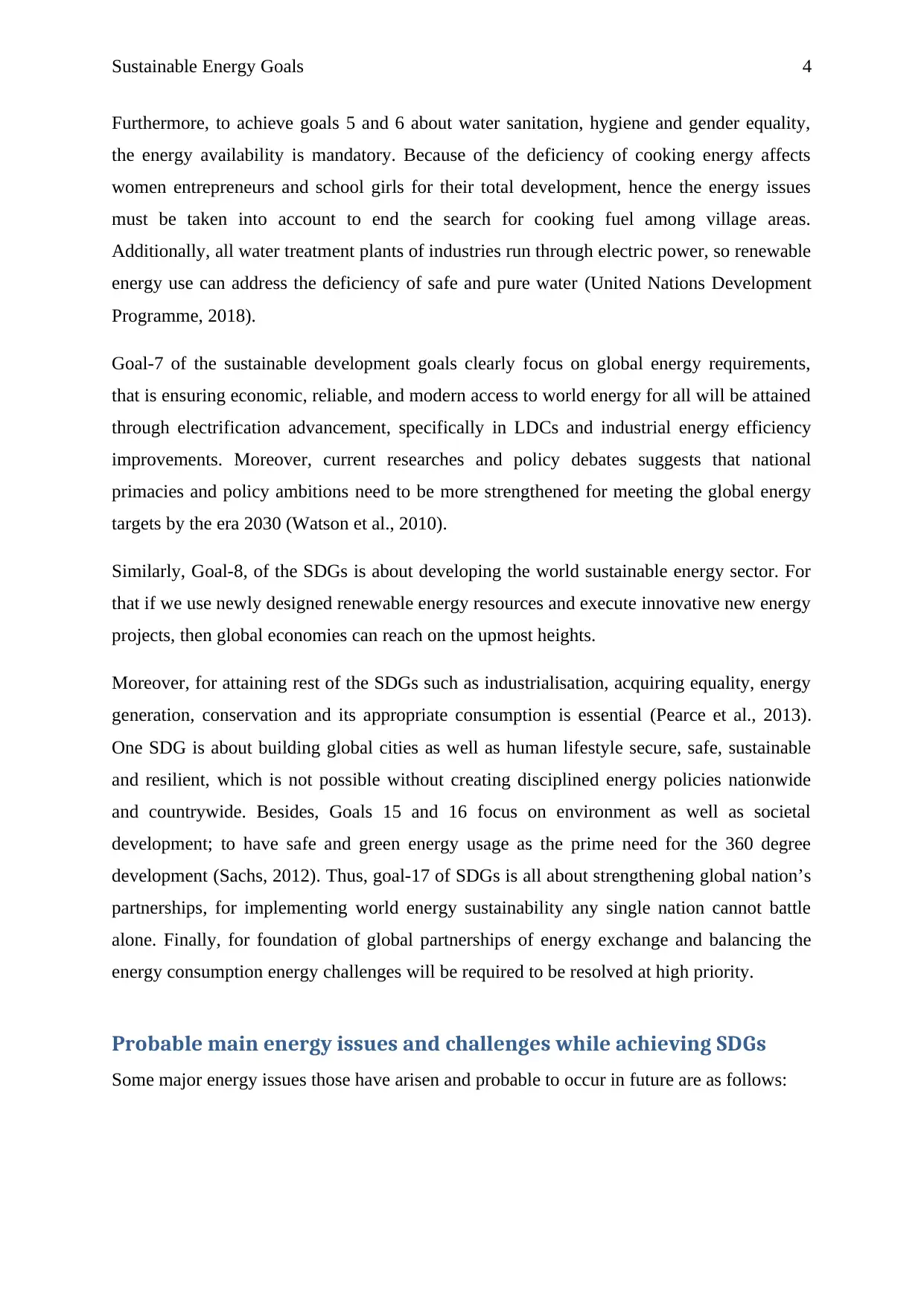
Sustainable Energy Goals 4
Furthermore, to achieve goals 5 and 6 about water sanitation, hygiene and gender equality,
the energy availability is mandatory. Because of the deficiency of cooking energy affects
women entrepreneurs and school girls for their total development, hence the energy issues
must be taken into account to end the search for cooking fuel among village areas.
Additionally, all water treatment plants of industries run through electric power, so renewable
energy use can address the deficiency of safe and pure water (United Nations Development
Programme, 2018).
Goal-7 of the sustainable development goals clearly focus on global energy requirements,
that is ensuring economic, reliable, and modern access to world energy for all will be attained
through electrification advancement, specifically in LDCs and industrial energy efficiency
improvements. Moreover, current researches and policy debates suggests that national
primacies and policy ambitions need to be more strengthened for meeting the global energy
targets by the era 2030 (Watson et al., 2010).
Similarly, Goal-8, of the SDGs is about developing the world sustainable energy sector. For
that if we use newly designed renewable energy resources and execute innovative new energy
projects, then global economies can reach on the upmost heights.
Moreover, for attaining rest of the SDGs such as industrialisation, acquiring equality, energy
generation, conservation and its appropriate consumption is essential (Pearce et al., 2013).
One SDG is about building global cities as well as human lifestyle secure, safe, sustainable
and resilient, which is not possible without creating disciplined energy policies nationwide
and countrywide. Besides, Goals 15 and 16 focus on environment as well as societal
development; to have safe and green energy usage as the prime need for the 360 degree
development (Sachs, 2012). Thus, goal-17 of SDGs is all about strengthening global nation’s
partnerships, for implementing world energy sustainability any single nation cannot battle
alone. Finally, for foundation of global partnerships of energy exchange and balancing the
energy consumption energy challenges will be required to be resolved at high priority.
Probable main energy issues and challenges while achieving SDGs
Some major energy issues those have arisen and probable to occur in future are as follows:
Furthermore, to achieve goals 5 and 6 about water sanitation, hygiene and gender equality,
the energy availability is mandatory. Because of the deficiency of cooking energy affects
women entrepreneurs and school girls for their total development, hence the energy issues
must be taken into account to end the search for cooking fuel among village areas.
Additionally, all water treatment plants of industries run through electric power, so renewable
energy use can address the deficiency of safe and pure water (United Nations Development
Programme, 2018).
Goal-7 of the sustainable development goals clearly focus on global energy requirements,
that is ensuring economic, reliable, and modern access to world energy for all will be attained
through electrification advancement, specifically in LDCs and industrial energy efficiency
improvements. Moreover, current researches and policy debates suggests that national
primacies and policy ambitions need to be more strengthened for meeting the global energy
targets by the era 2030 (Watson et al., 2010).
Similarly, Goal-8, of the SDGs is about developing the world sustainable energy sector. For
that if we use newly designed renewable energy resources and execute innovative new energy
projects, then global economies can reach on the upmost heights.
Moreover, for attaining rest of the SDGs such as industrialisation, acquiring equality, energy
generation, conservation and its appropriate consumption is essential (Pearce et al., 2013).
One SDG is about building global cities as well as human lifestyle secure, safe, sustainable
and resilient, which is not possible without creating disciplined energy policies nationwide
and countrywide. Besides, Goals 15 and 16 focus on environment as well as societal
development; to have safe and green energy usage as the prime need for the 360 degree
development (Sachs, 2012). Thus, goal-17 of SDGs is all about strengthening global nation’s
partnerships, for implementing world energy sustainability any single nation cannot battle
alone. Finally, for foundation of global partnerships of energy exchange and balancing the
energy consumption energy challenges will be required to be resolved at high priority.
Probable main energy issues and challenges while achieving SDGs
Some major energy issues those have arisen and probable to occur in future are as follows:
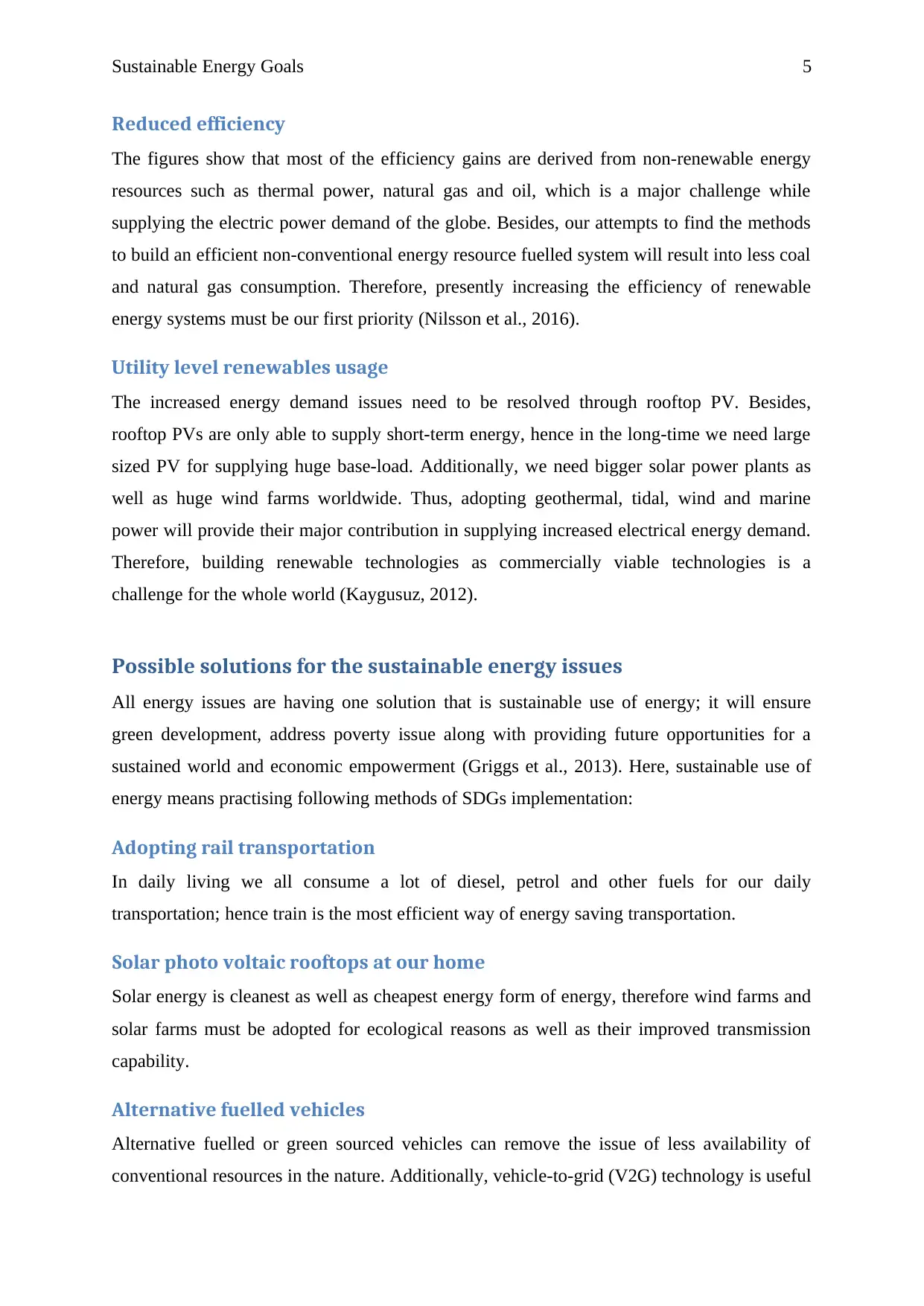
Sustainable Energy Goals 5
Reduced efficiency
The figures show that most of the efficiency gains are derived from non-renewable energy
resources such as thermal power, natural gas and oil, which is a major challenge while
supplying the electric power demand of the globe. Besides, our attempts to find the methods
to build an efficient non-conventional energy resource fuelled system will result into less coal
and natural gas consumption. Therefore, presently increasing the efficiency of renewable
energy systems must be our first priority (Nilsson et al., 2016).
Utility level renewables usage
The increased energy demand issues need to be resolved through rooftop PV. Besides,
rooftop PVs are only able to supply short-term energy, hence in the long-time we need large
sized PV for supplying huge base-load. Additionally, we need bigger solar power plants as
well as huge wind farms worldwide. Thus, adopting geothermal, tidal, wind and marine
power will provide their major contribution in supplying increased electrical energy demand.
Therefore, building renewable technologies as commercially viable technologies is a
challenge for the whole world (Kaygusuz, 2012).
Possible solutions for the sustainable energy issues
All energy issues are having one solution that is sustainable use of energy; it will ensure
green development, address poverty issue along with providing future opportunities for a
sustained world and economic empowerment (Griggs et al., 2013). Here, sustainable use of
energy means practising following methods of SDGs implementation:
Adopting rail transportation
In daily living we all consume a lot of diesel, petrol and other fuels for our daily
transportation; hence train is the most efficient way of energy saving transportation.
Solar photo voltaic rooftops at our home
Solar energy is cleanest as well as cheapest energy form of energy, therefore wind farms and
solar farms must be adopted for ecological reasons as well as their improved transmission
capability.
Alternative fuelled vehicles
Alternative fuelled or green sourced vehicles can remove the issue of less availability of
conventional resources in the nature. Additionally, vehicle-to-grid (V2G) technology is useful
Reduced efficiency
The figures show that most of the efficiency gains are derived from non-renewable energy
resources such as thermal power, natural gas and oil, which is a major challenge while
supplying the electric power demand of the globe. Besides, our attempts to find the methods
to build an efficient non-conventional energy resource fuelled system will result into less coal
and natural gas consumption. Therefore, presently increasing the efficiency of renewable
energy systems must be our first priority (Nilsson et al., 2016).
Utility level renewables usage
The increased energy demand issues need to be resolved through rooftop PV. Besides,
rooftop PVs are only able to supply short-term energy, hence in the long-time we need large
sized PV for supplying huge base-load. Additionally, we need bigger solar power plants as
well as huge wind farms worldwide. Thus, adopting geothermal, tidal, wind and marine
power will provide their major contribution in supplying increased electrical energy demand.
Therefore, building renewable technologies as commercially viable technologies is a
challenge for the whole world (Kaygusuz, 2012).
Possible solutions for the sustainable energy issues
All energy issues are having one solution that is sustainable use of energy; it will ensure
green development, address poverty issue along with providing future opportunities for a
sustained world and economic empowerment (Griggs et al., 2013). Here, sustainable use of
energy means practising following methods of SDGs implementation:
Adopting rail transportation
In daily living we all consume a lot of diesel, petrol and other fuels for our daily
transportation; hence train is the most efficient way of energy saving transportation.
Solar photo voltaic rooftops at our home
Solar energy is cleanest as well as cheapest energy form of energy, therefore wind farms and
solar farms must be adopted for ecological reasons as well as their improved transmission
capability.
Alternative fuelled vehicles
Alternative fuelled or green sourced vehicles can remove the issue of less availability of
conventional resources in the nature. Additionally, vehicle-to-grid (V2G) technology is useful
⊘ This is a preview!⊘
Do you want full access?
Subscribe today to unlock all pages.

Trusted by 1+ million students worldwide
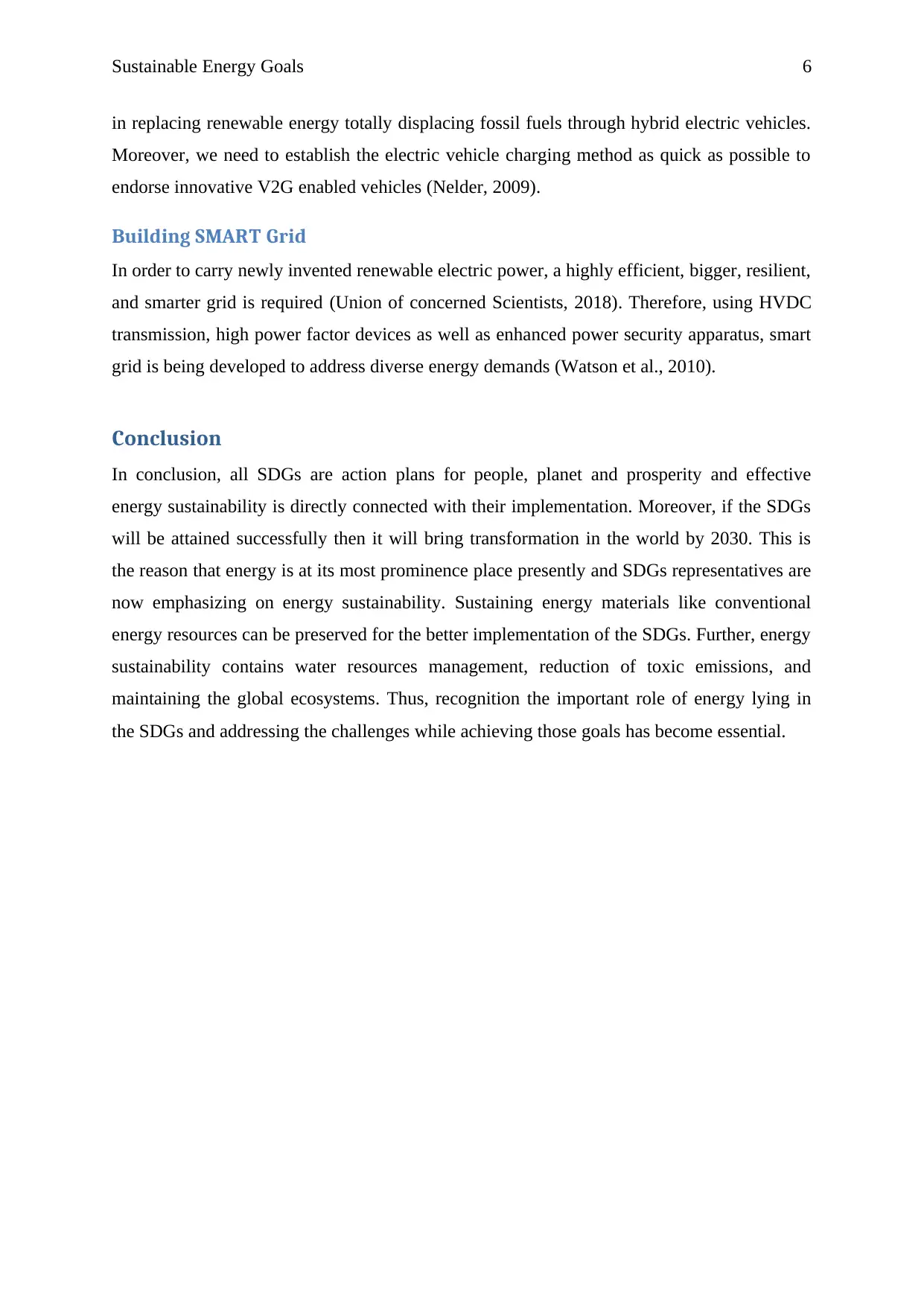
Sustainable Energy Goals 6
in replacing renewable energy totally displacing fossil fuels through hybrid electric vehicles.
Moreover, we need to establish the electric vehicle charging method as quick as possible to
endorse innovative V2G enabled vehicles (Nelder, 2009).
Building SMART Grid
In order to carry newly invented renewable electric power, a highly efficient, bigger, resilient,
and smarter grid is required (Union of concerned Scientists, 2018). Therefore, using HVDC
transmission, high power factor devices as well as enhanced power security apparatus, smart
grid is being developed to address diverse energy demands (Watson et al., 2010).
Conclusion
In conclusion, all SDGs are action plans for people, planet and prosperity and effective
energy sustainability is directly connected with their implementation. Moreover, if the SDGs
will be attained successfully then it will bring transformation in the world by 2030. This is
the reason that energy is at its most prominence place presently and SDGs representatives are
now emphasizing on energy sustainability. Sustaining energy materials like conventional
energy resources can be preserved for the better implementation of the SDGs. Further, energy
sustainability contains water resources management, reduction of toxic emissions, and
maintaining the global ecosystems. Thus, recognition the important role of energy lying in
the SDGs and addressing the challenges while achieving those goals has become essential.
in replacing renewable energy totally displacing fossil fuels through hybrid electric vehicles.
Moreover, we need to establish the electric vehicle charging method as quick as possible to
endorse innovative V2G enabled vehicles (Nelder, 2009).
Building SMART Grid
In order to carry newly invented renewable electric power, a highly efficient, bigger, resilient,
and smarter grid is required (Union of concerned Scientists, 2018). Therefore, using HVDC
transmission, high power factor devices as well as enhanced power security apparatus, smart
grid is being developed to address diverse energy demands (Watson et al., 2010).
Conclusion
In conclusion, all SDGs are action plans for people, planet and prosperity and effective
energy sustainability is directly connected with their implementation. Moreover, if the SDGs
will be attained successfully then it will bring transformation in the world by 2030. This is
the reason that energy is at its most prominence place presently and SDGs representatives are
now emphasizing on energy sustainability. Sustaining energy materials like conventional
energy resources can be preserved for the better implementation of the SDGs. Further, energy
sustainability contains water resources management, reduction of toxic emissions, and
maintaining the global ecosystems. Thus, recognition the important role of energy lying in
the SDGs and addressing the challenges while achieving those goals has become essential.
Paraphrase This Document
Need a fresh take? Get an instant paraphrase of this document with our AI Paraphraser
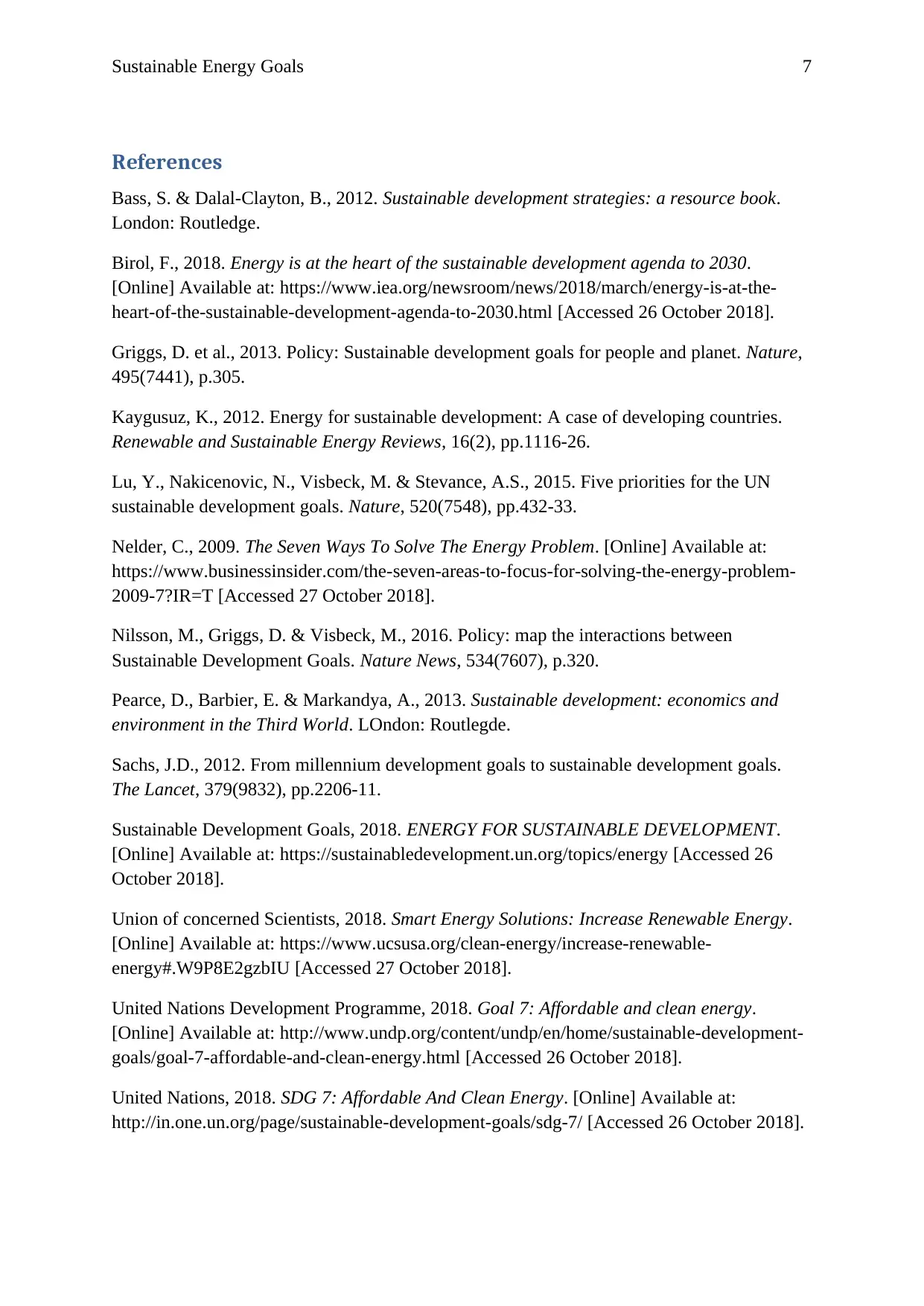
Sustainable Energy Goals 7
References
Bass, S. & Dalal-Clayton, B., 2012. Sustainable development strategies: a resource book.
London: Routledge.
Birol, F., 2018. Energy is at the heart of the sustainable development agenda to 2030.
[Online] Available at: https://www.iea.org/newsroom/news/2018/march/energy-is-at-the-
heart-of-the-sustainable-development-agenda-to-2030.html [Accessed 26 October 2018].
Griggs, D. et al., 2013. Policy: Sustainable development goals for people and planet. Nature,
495(7441), p.305.
Kaygusuz, K., 2012. Energy for sustainable development: A case of developing countries.
Renewable and Sustainable Energy Reviews, 16(2), pp.1116-26.
Lu, Y., Nakicenovic, N., Visbeck, M. & Stevance, A.S., 2015. Five priorities for the UN
sustainable development goals. Nature, 520(7548), pp.432-33.
Nelder, C., 2009. The Seven Ways To Solve The Energy Problem. [Online] Available at:
https://www.businessinsider.com/the-seven-areas-to-focus-for-solving-the-energy-problem-
2009-7?IR=T [Accessed 27 October 2018].
Nilsson, M., Griggs, D. & Visbeck, M., 2016. Policy: map the interactions between
Sustainable Development Goals. Nature News, 534(7607), p.320.
Pearce, D., Barbier, E. & Markandya, A., 2013. Sustainable development: economics and
environment in the Third World. LOndon: Routlegde.
Sachs, J.D., 2012. From millennium development goals to sustainable development goals.
The Lancet, 379(9832), pp.2206-11.
Sustainable Development Goals, 2018. ENERGY FOR SUSTAINABLE DEVELOPMENT.
[Online] Available at: https://sustainabledevelopment.un.org/topics/energy [Accessed 26
October 2018].
Union of concerned Scientists, 2018. Smart Energy Solutions: Increase Renewable Energy.
[Online] Available at: https://www.ucsusa.org/clean-energy/increase-renewable-
energy#.W9P8E2gzbIU [Accessed 27 October 2018].
United Nations Development Programme, 2018. Goal 7: Affordable and clean energy.
[Online] Available at: http://www.undp.org/content/undp/en/home/sustainable-development-
goals/goal-7-affordable-and-clean-energy.html [Accessed 26 October 2018].
United Nations, 2018. SDG 7: Affordable And Clean Energy. [Online] Available at:
http://in.one.un.org/page/sustainable-development-goals/sdg-7/ [Accessed 26 October 2018].
References
Bass, S. & Dalal-Clayton, B., 2012. Sustainable development strategies: a resource book.
London: Routledge.
Birol, F., 2018. Energy is at the heart of the sustainable development agenda to 2030.
[Online] Available at: https://www.iea.org/newsroom/news/2018/march/energy-is-at-the-
heart-of-the-sustainable-development-agenda-to-2030.html [Accessed 26 October 2018].
Griggs, D. et al., 2013. Policy: Sustainable development goals for people and planet. Nature,
495(7441), p.305.
Kaygusuz, K., 2012. Energy for sustainable development: A case of developing countries.
Renewable and Sustainable Energy Reviews, 16(2), pp.1116-26.
Lu, Y., Nakicenovic, N., Visbeck, M. & Stevance, A.S., 2015. Five priorities for the UN
sustainable development goals. Nature, 520(7548), pp.432-33.
Nelder, C., 2009. The Seven Ways To Solve The Energy Problem. [Online] Available at:
https://www.businessinsider.com/the-seven-areas-to-focus-for-solving-the-energy-problem-
2009-7?IR=T [Accessed 27 October 2018].
Nilsson, M., Griggs, D. & Visbeck, M., 2016. Policy: map the interactions between
Sustainable Development Goals. Nature News, 534(7607), p.320.
Pearce, D., Barbier, E. & Markandya, A., 2013. Sustainable development: economics and
environment in the Third World. LOndon: Routlegde.
Sachs, J.D., 2012. From millennium development goals to sustainable development goals.
The Lancet, 379(9832), pp.2206-11.
Sustainable Development Goals, 2018. ENERGY FOR SUSTAINABLE DEVELOPMENT.
[Online] Available at: https://sustainabledevelopment.un.org/topics/energy [Accessed 26
October 2018].
Union of concerned Scientists, 2018. Smart Energy Solutions: Increase Renewable Energy.
[Online] Available at: https://www.ucsusa.org/clean-energy/increase-renewable-
energy#.W9P8E2gzbIU [Accessed 27 October 2018].
United Nations Development Programme, 2018. Goal 7: Affordable and clean energy.
[Online] Available at: http://www.undp.org/content/undp/en/home/sustainable-development-
goals/goal-7-affordable-and-clean-energy.html [Accessed 26 October 2018].
United Nations, 2018. SDG 7: Affordable And Clean Energy. [Online] Available at:
http://in.one.un.org/page/sustainable-development-goals/sdg-7/ [Accessed 26 October 2018].

Sustainable Energy Goals 8
Watson, R.T., Boudreau, M.C. & Chen, A.J., 2010. Information systems and environmentally
sustainable development: energy informatics and new directions for the IS community. MIS
Quarterly, pp.23-38.
Watson, R.T., Boudreau, M.C. & Chen, A.J., 2010. Information systems and environmentally
sustainable development: energy informatics and new directions for the IS community. MIS
Quarterly, pp.23-38.
⊘ This is a preview!⊘
Do you want full access?
Subscribe today to unlock all pages.

Trusted by 1+ million students worldwide
1 out of 9
Related Documents
Your All-in-One AI-Powered Toolkit for Academic Success.
+13062052269
info@desklib.com
Available 24*7 on WhatsApp / Email
![[object Object]](/_next/static/media/star-bottom.7253800d.svg)
Unlock your academic potential
Copyright © 2020–2025 A2Z Services. All Rights Reserved. Developed and managed by ZUCOL.




